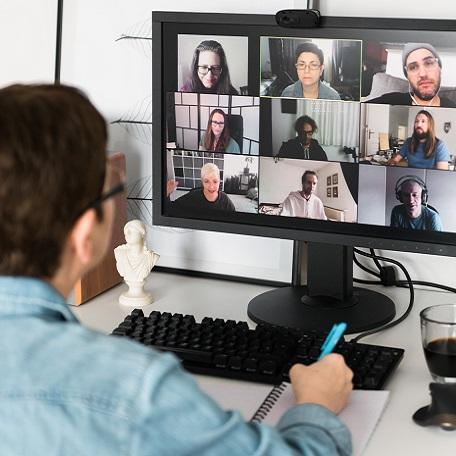The Covid-19 pandemic created an education crisis, with in-person schools and training programs halted or greatly delayed. It also led to record global unemployment and increased poverty.
Reskilling was already important before the crisis but became even more so as inequality and the digital divide were further exposed.
However, it also led to opportunities to reframe our ideas of how to learn and helped us reexamine how to “build forward better” including developing new skills (in areas such as sustainability) and creating new blended or hybrid learning platforms.
Simulation-based programming and new EdTech (education technology) solutions are expanding opportunities for training and employment for underserved communities. Impact investors such as Omidyar Network in India have helped to further accelerate these opportunities by funding/supporting EdTech ventures with promising new models and platforms.
It is important for vocational training and education-focused initiatives to collaborate with industries in order to link directly to jobs, especially for unemployed or underemployed youth in underserved communities.

The Covid-19 pandemic has created an education crisis.
The Covid-19 pandemic created an education crisis, with in-person schools and training programs halted or greatly delayed around the world. At the same time, the pandemic led to record unemployment and increased poverty. The International Labour Organization (ILO) estimates that 14 percent of working hours were lost globally, the equivalent of the loss of 480 million full time jobs. While reskilling was already important before the crisis, it became even more important as the pandemic further exposed inequality and the digital divide.
Business for Inclusive Growth (B4IG), a coalition of global companies, has set its sights on collective action to address the digital divide. Camille Putois, the CEO of B4IG, told CLUED-iN: “The crisis has shown that even in developed countries, in strong digital economies, large sections of society do not have adequate access to digital infrastructure.” While many companies have initiatives to provide digital skills and hardware, collective action and partnerships are key.

We need to bridge the digital divide.
While the Covid-19 pandemic created an educational crisis, it also led to opportunities to reframe learning and reexamine the big picture of how to “build forward better” while developing new skills and creating blended learning systems. Blended learning is an approach that blends traditional instruction with digital education technology, such as combining printed materials with mobile quizzes or merging physical skills training with online simulations.
Marc Castagnet advises French higher education group IGS, which facilitates degree programs in Africa, India and China. “For me, the divide between online and physical learning is wrong, and the focus now is on blended learning,” he argues. The pandemic has accelerated this shift to new platforms and learning models. “The shift to this type of learning should have taken ten years, but because of Covid it has already happened.”
Bridge International Academies in Kenya, featured in iBAN’s video “Inclusive Business: Companies as a Force for Good”, integrated new formats such as WhatsApp mobile quizzes into their @home learning system. Managing Director Reuben Wambugu told us that new tools are here to stay. “We see the @home learning approach and teaching materials we have developed during the pandemic as complementary tools, which our teachers, parents and pupils will be using to enhance the learning experience, even with schools now reopened. These are now being integrated into school programmes - under the heading of 'blended learning'.”
In rural areas with little access to computers or smartphones, inclusive businesses have developed new solutions. Industree, which is focused on women’s livelihood skills training, relied on projectors as well as audio and visual trainings, and used their networks to check on trainees’ welfare and training progress.

Covid-19 has accelerated the move towards online learning.
Simulation-based programming and new EdTech (education technology) solutions are expanding opportunities for training and employment for underserved communities. Impact investors such as Omidyar Network have helped to further accelerate these innovations by funding and supporting EdTech ventures with promising new models and platforms. They have seen new platforms arise in India that focus not only on job placement but also on continuous upskilling. “I think what we're seeing are platforms that want to be the de facto platform for more training and continuous demand for job creation,” said Sarvesh Kanodia. Blended learning models are more efficient but need further support. “What we need to ask, going forward, is ‘How do you make it blended?’ Funding support is needed for some organizations working on the ground to implement tech solutions and convert part of their physical-only programs to blended online programs,” he adds.
One example of a hybrid learning platform is the Shiksha model developed in one month by LabourNet in response to the pandemic. As Gayathri Vasudevan, the CEO of LabourNet explains, “Shiksha today supports face-to-face virtual sessions akin to a smart class, self-learning management with assessments capability, as well as social learning features like online discussion spaces.” The Shiksha platform is being used in both centre-based models for traditional trades and in online skilling models for future IT skills. Specific skills in sectors such as hygiene and healthcare have become particularly important.

How do you make it blended?
The connection between skills training and employment is critical. “Reskilling or upskilling is only valid if there are jobs at the end,” says Marc Castagnet. It is important for vocational training and education to link directly to jobs, especially for unemployed or underemployed youth in underserved areas. As Ms. Vasudevan explains, LabourNet is accomplishing this by collaborating with industry. “We are re-organizing skilling closer to work sites, so as to incorporate industry needs deeper into learning experiences and bridge the traditional education and employability gap.”

Training programs need to fit company demands to ensure employability.
The shift to new learning styles is accompanied by an opportunity to focus on developing new skills for a sustainable future. In her blog, Laura Asiala of WholeWorks explains that using new formats and simulation-based training can prepare business leaders for sustainable transformation and value creation. “Learning the concepts is important to reskilling leaders and professionals — but practice is crucial,” she argues.
The Covid-19 pandemic has created both a crisis and an opportunity for education and skills training by hastening the movement to digital and blended learning. This has led to learning innovations and a renewed focus on building forward better to provide the job skills required for a sustainable, inclusive future.

The pandemic makes education providers take new paths.
- TechLearning, 15 Sites for Blended Learning: Blended learning is a teaching approach that combines both traditional instruction and digital technologies to create lessons. Find here a list of sites providing support, lessons and other resources for educators using a blended learning approach.
- Future Learn, Blended Learning Essentials for Vocational Education and Training: This ExpertTrack contains essential knowledge for teachers, trainers and managers who are developing blended learning and preparing learners to succeed in the workplace.
- International Labour Organization, Skills development in the time of COVID-19: Taking stock of the initial responses in technical and vocational education and training: This report is based on the findings of an interagency survey on technical and vocational education and training (TVET) and skills development in the time of COVID-19. The survey, which collected data from 1,353 respondents, representing 126 countries from all over the world captured the main challenges faced by TVET institutions during this crisis and brought to light innovations in teaching and learning.
Slider Images: © Industree (artisan at work), © WholeWorks (trainee attending virtual team meeting), Unsplash (globe)
All other images: Unsplash




